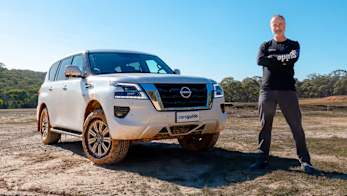Kia has detailed its PV5 electric van in Korea ahead of its international debut.
The new van is the first in a range of clean-sheet upcoming electric light commercial vehicles from Kia, which it hopes will establish it in a new market segment.
Available initially in five-seat passenger and two-seat commercial form, the PV5 is built on a variation of Hyundai Group’s e-GMP platform and features a modular system for its internal fittings, allowing it to be configured to a variety of needs.
The passenger and Long Range Cargo version is equipped with a 71.2kWh battery pack, granting it a combined driving range of up to 358km according to Korean specifications, while the Standard Range Cargo version is equipped with a 51.5kWh battery. It drives the front wheels via a 90kW/250Nm motor for the Standard Range, or a 120kW/250Nm motor for the Long Range.
It features a boxy and space-maximising design, with dual sliding doors at the rear which open up to 775mm “for easy boarding and disembarkation” while the interior features a low beltline to make for maximum driver visibility, according to the brand.
The passenger version features a second row of seats, which are able to fold into a bed layout with an optional luggage deck feature, while the boot floor features storage trays underneath
Other standard features include either steel or alloy 16-inch wheels, a 12.9-inch multimedia touchscreen with a software configuration unique to Kia’s PBV range, a 7.5-inch digital instrument cluster, a storage bay cut out of the dash behind the digital instrument display, as well as both indoor and outdoor vehicle-to-load connectors to power household or work appliances.
It also supports a range of modular extras (dubbed Kia AddGear), like a fitted sunglasses case for the driver’s instrument area, a cupholder for the back of the centre console, a magnetic hook for roof fittings, or an umbrella stand which fits into the boot lining.
The PV5 is capable of charging from 10 - 80 per cent in 30 minutes and has a 400-volt battery architecture capable of accepting up to 150kW on a compatible DC pylon.
Payload is rated at up to 790kg for the Standard Range version, or 690kg for the Long Range while the cargo volume area is 4.4 cubic metres. The passenger version reduces payload to 605kg and the load area to 2.4 cubic meters with the rear bench slid as far back as it can go, or 3.7 cubic meters with it slid forward as far as it can go. The Cargo variant is equipped with a barn door rear, while the Passenger version has a lifting tailgate.
.jpg)
A cab chassis version is also slated to launch at a later date, with a payload of up to 995kg.
In its South Korean home market, the PV5 starts from the equivalent of A$47,000 for the base Standard Range Cargo version, reaching to A$61,160 for the top-spec Passenger version. Meanwhile right-hand drive versions in the UK range from $68,900 - $82,200. For context, the ID.Buzz ranges from $79,990 - $87,990 for equivalent Cargo and five-seat versions.
As of May this year, the PV5 had not yet been confirmed for an Australian arrival, but the brand said it “had its hand up” for the van. It is already available in right-hand drive for the UK market.
.jpg)
If sold in Australia, the PV5 would serve as a people mover a size-bracket under the Carnival, or as the brand’s first rival to something like the LDV eDeliver 7 on the commercial front.
Kia is on a roll in 2025, building on its range of fully electric passenger cars with the EV3 and EV5, but also moving into the dual-cab space with its Tasman ute, which it hopes will sell up to 20,000 units a year.

.jpg)

.jpg)

.jpg)
.jpg)
.jpg)
.jpg)

.jpg)




.jpg)
.jpg)
.jpg)
.jpg)
.jpg)
.jpg)
.jpg)
.jpg)
.jpg)
.jpg)



